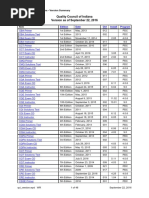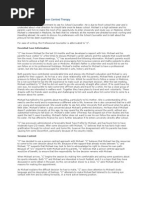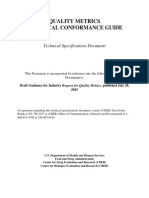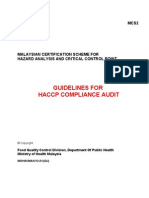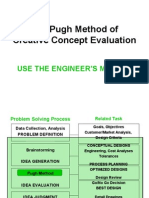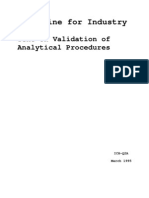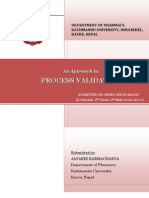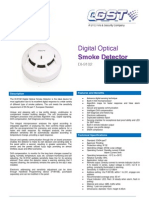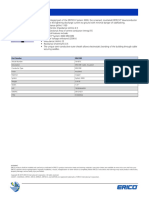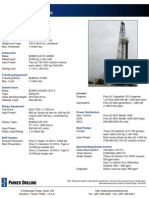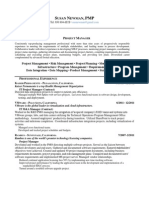Deming PDCA
Deming PDCA
Uploaded by
Rajaram SastryCopyright:
Available Formats
Deming PDCA
Deming PDCA
Uploaded by
Rajaram SastryOriginal Description:
Copyright
Available Formats
Share this document
Did you find this document useful?
Is this content inappropriate?
Copyright:
Available Formats
Deming PDCA
Deming PDCA
Uploaded by
Rajaram SastryCopyright:
Available Formats
Deming estimated that 85% of problems in an organization were caused by inadequate processes and only 15% caused by operator
error. Therefore, it simply makes sense that corrective action is taken on the process first unless you are absolutely sure that your problem was caused by operator error. Despite this statistic, too many individuals choose what seems to be the easy way to "eliminate" a problem by talking to the operator about the problem. Yes, you will probably see short-term improvement using this method, but it is very likely that your problem will return. So how do you prevent this from happening within your organization? You guessed it... proper use of the Deming Cycle. What we've learned over the years is that many have oversimplified the use of this tool. I wish I could tell you it's as simple as Plan- Do- Study- Act, or PDSA, but I can't honestly do that. A poorly executed plan will lead to horrible results. A poorly identified problem will lead to an incorrect solution. These will, in every instance, lead to poor data to analyze, and leave you wondering what to do to make the problem go away. You could just as easily chosen operator error or fire fighting and gotten the same poor result. What we've done is to take apart the PDSA cycle and break it down into simple and effective problem solving steps
The Deming Cycle By Paul Arveson W. Edwards Deming in the 1950's proposed that business processes should be analyzed and measured to identify sources of variations that cause products to deviate from customer requirements. He recommended that business processes be placed in a continuous feedback loop so that managers can identify and change the parts of the process that need improvements. As a teacher, Deming created a (rather oversimplified) diagram to illustrate this continuous process, commonly known as the PDCA cycle for Plan, Do, Check, Act*:
PLAN: Design or revise business process components to improve results DO: Implement the plan and measure its performance CHECK: Assess the measurements and report the results to decision makers ACT: Decide on changes needed to improve the process
Plan
The above picture shows how the Deming Cycle operates. The Plan stage is where it all begins. Prior to implementing a change you must understand both the nature of your
current problem and how your process failed to meet a customer requirement. You and/or your problem solving team determine: Which process needs improved How much improvement is required The change to be implemented When the change is to be implemented How you plan to measure the effect of the change What will be affected by this change (documents, procedures, etc.). Once you have this plan, its time to move to the DO stage.
Do
The Do stage is the implementation of the change. Identify the people affected by the change and inform them that youre adapting their process due to customer complaints, multiple failures, continual improvement opportunity, whatever the reason, it is important to let them know about the change. Youll need their buy-in to help ensure the effectiveness of the change. Then implement the change, including the measurements youll need in the Study stage. Monitor the change after implementation to make sure no backsliding occurs. You wouldnt want people to return to the old methods of operation- those methods were causing your company pain to begin with!
Study
Just as it implies, the Study stage is where youll perform analysis of the data you collected during the Do stage. Considerations include: Did the process improve? By how much? Did we meet the objective for the improvement? Was the process more difficult to use with the new methods? Get a FREE action plan template just for subscribing to our newsletter!
Act
The answers from the Study stage define your tasks for the Act stage. For example, if the process didnt improve, theres no point in asking additional questions during the Study stage. But action can be taken- action must be taken! The problem hasnt been solved. The action youd take is to eliminate the change you implemented in the Do stage and return to the Plan stage to consider new options to implement. If the process did improve, youd want to know if there was enou gh improvement. More simply, if the improvement was to speed up the process, is the process now fast enough
to meet requirements? If not, consider additional methods to tweak the process so that you do meet improvement objectives. Again, youre back at the Plan stage of the Deming Cycle. Suppose you met the improvement objectives. Interview the process owner and some process participants to determine their thoughts regarding the change you implemented. They are your immediate customer. You want their feedback. If you didnt make the process harder (read more costly or time consuming) your action in this case would be to standardize your improvement by changing any required documentation and conduct training regarding the change. Keep in mind that sometimes you will make the process more time consuming. But if the savings from the change more than offset the additional cost, youre likely to have implemented an appropriate change
Revisiting the Improvement
Thats right youre not done yet. You want to Sustain the Gain. Know that the change is still in place, and still effective. A review of the process and measure should give you this information. Watch the process to view for yourself that the process operators are performing the process using the improvements youve implemented. Analyze the metrics to ensure effectiveness of your Deming Cycle improvements.
You might also like
- CGMP Part 1 Annual Training TennexDocument43 pagesCGMP Part 1 Annual Training TennexawwNo ratings yet
- Supplier Quality Management A Complete Guide - 2021 EditionFrom EverandSupplier Quality Management A Complete Guide - 2021 EditionNo ratings yet
- Qci VersionDocument48 pagesQci VersionSAPCertification50% (2)
- Case Demonstrating Person Centred TherapyDocument4 pagesCase Demonstrating Person Centred TherapyRajaram SastryNo ratings yet
- Case Demonstrating Person Centred TherapyDocument4 pagesCase Demonstrating Person Centred TherapyRajaram SastryNo ratings yet
- Landscape Lighting - DissertationDocument37 pagesLandscape Lighting - DissertationRadhika MohanNo ratings yet
- Manufacturing System: Prepared byDocument33 pagesManufacturing System: Prepared bynorizayusofNo ratings yet
- Assessing Acceptance SamplingDocument7 pagesAssessing Acceptance SamplingMuhamad FaizinNo ratings yet
- Guideline On General Principles of Process ValidationDocument23 pagesGuideline On General Principles of Process ValidationI-Sun Deep Mohan TeaNo ratings yet
- What Is ValidationDocument6 pagesWhat Is ValidationVishal VakilNo ratings yet
- Reflow SolderingDocument6 pagesReflow Solderingputut margandonoNo ratings yet
- Root Cause Analysis Article Improving FishboneDocument4 pagesRoot Cause Analysis Article Improving FishbonebaioccojNo ratings yet
- G65 BRC Checklist (1aug10) 2Document15 pagesG65 BRC Checklist (1aug10) 2Asep RNo ratings yet
- Acceptance Sampling & OC CurveDocument3 pagesAcceptance Sampling & OC CurveMohit BihaniNo ratings yet
- The Key Tool For Executing Focused Improvement: 12 Step Kaizen StoryDocument11 pagesThe Key Tool For Executing Focused Improvement: 12 Step Kaizen StoryNadol Swasnatee100% (1)
- PMP Exam Tips On Time Management, Third EditionDocument5 pagesPMP Exam Tips On Time Management, Third EditionWilliam Luque Lds100% (1)
- Manual Sampling Guidelines 25-05-2016Document47 pagesManual Sampling Guidelines 25-05-2016Rajam SankarNo ratings yet
- Clinica Chimica Acta: SciencedirectDocument6 pagesClinica Chimica Acta: SciencedirectJulián Mesa SierraNo ratings yet
- User Requirements Template RAJADocument25 pagesUser Requirements Template RAJAdrs_mdu480% (1)
- Metrology: Bob O'Brien Dave Miller NHCTC at PeaseDocument129 pagesMetrology: Bob O'Brien Dave Miller NHCTC at PeaseOula HatahetNo ratings yet
- Radiation Dose Setting - Tech TipDocument6 pagesRadiation Dose Setting - Tech Tipjchav004ucrNo ratings yet
- Quality Management Systems A Complete Guide - 2021 EditionFrom EverandQuality Management Systems A Complete Guide - 2021 EditionNo ratings yet
- Sampling Plans: Trainer: Balakrishnan Srinivasan Position: Process and Quality Improvement ExecutiveDocument31 pagesSampling Plans: Trainer: Balakrishnan Srinivasan Position: Process and Quality Improvement ExecutiveBALAKRISHNANNo ratings yet
- Quality QuizDocument2 pagesQuality QuizFrankMartinezNo ratings yet
- 4 Cleaning Val 99091Document28 pages4 Cleaning Val 99091Mohamed KamalNo ratings yet
- SanofiManufacturingSystem SMSDocument4 pagesSanofiManufacturingSystem SMSTIEN VAN ANH THUY100% (1)
- Environmental Laboratory Approval Program Certification ManualDocument69 pagesEnvironmental Laboratory Approval Program Certification Manualmohsin931No ratings yet
- 8D Report Training MIDDocument23 pages8D Report Training MIDanon_86320488No ratings yet
- GLPDocument10 pagesGLPsanjeevbhatNo ratings yet
- What Is Acceptable Quality Level PDFDocument4 pagesWhat Is Acceptable Quality Level PDFمصطفى عبدالرحيمNo ratings yet
- Glossary of Stability Testing Terms: ICH Q1 and FDA GuidanceDocument10 pagesGlossary of Stability Testing Terms: ICH Q1 and FDA Guidanceçağan ağtaşNo ratings yet
- Plan-Do-Check-Act Cycle (PDCA Cycle)Document2 pagesPlan-Do-Check-Act Cycle (PDCA Cycle)psathishthevanNo ratings yet
- Particulate Matter and Visual Inspection Industry Trends 2015Document48 pagesParticulate Matter and Visual Inspection Industry Trends 2015Blank BacktobasicNo ratings yet
- Target Product Profile: A Renaissance For Its Definition and UseDocument9 pagesTarget Product Profile: A Renaissance For Its Definition and UseKavya g nNo ratings yet
- Understand What Is A Benchmark and How It Is UsedDocument8 pagesUnderstand What Is A Benchmark and How It Is UsedSharah Del Tabudlong TudeNo ratings yet
- Current Good Manufacturing Practices in Food IndustryDocument3 pagesCurrent Good Manufacturing Practices in Food IndustryCarlNo ratings yet
- (NORMA) Request For Quality MetricsDocument14 pages(NORMA) Request For Quality MetricsJhovanaNo ratings yet
- Vendor Development QuestionnaireDocument15 pagesVendor Development QuestionnaireJahangir HossainNo ratings yet
- Early Production Containment TrainingDocument17 pagesEarly Production Containment TrainingSara AmsidderNo ratings yet
- Haccp 2.Document11 pagesHaccp 2.sadbad6No ratings yet
- Pall - Single Use SystemsDocument11 pagesPall - Single Use SystemsDAVI DE MATOS ALVES alu.ufc.brNo ratings yet
- ISO 9001-2000 Standard ChecklistDocument18 pagesISO 9001-2000 Standard Checklistzied maghrebiNo ratings yet
- GAMP5Document29 pagesGAMP5vjeevan5No ratings yet
- Six Sigma Glossary PDFDocument36 pagesSix Sigma Glossary PDFmancheung6429100% (1)
- GAP-GHP Audit Verification Program Policies and Procedures - 0Document170 pagesGAP-GHP Audit Verification Program Policies and Procedures - 0Sofianisa RozdiandaNo ratings yet
- JGXP - 2011 - v15n4 - Contamination Control in The Compliance Program PDFDocument7 pagesJGXP - 2011 - v15n4 - Contamination Control in The Compliance Program PDFNelson Alejandro FierroNo ratings yet
- The Pugh MethodDocument21 pagesThe Pugh Methodshahua100% (1)
- Risk-Based Approaches in GMP's ProjectDocument27 pagesRisk-Based Approaches in GMP's ProjectRonaldo JanglinNo ratings yet
- CP CPK Capability Calculation Sheet v3Document11 pagesCP CPK Capability Calculation Sheet v3Axel GNo ratings yet
- Lab Notebook Presentation - 8-12-2016Document44 pagesLab Notebook Presentation - 8-12-2016Muhammad ALi Soomro100% (1)
- Validation1 0506Document26 pagesValidation1 0506jonh366No ratings yet
- Ich Validation 2qaDocument9 pagesIch Validation 2qaBishal AdhikariNo ratings yet
- Definitive Guide To Integrative Improvement TRACC 516Document116 pagesDefinitive Guide To Integrative Improvement TRACC 516Eusebio NavarroNo ratings yet
- What Is Strategy and Why Is It Important?Document17 pagesWhat Is Strategy and Why Is It Important?Anonymous nD4KwhNo ratings yet
- GMP History PDFDocument49 pagesGMP History PDFSubhradipNo ratings yet
- PQ-example Guidelis SampleDocument6 pagesPQ-example Guidelis Sampleasit_mNo ratings yet
- Equipment Calibration IntervalsDocument4 pagesEquipment Calibration IntervalsAhmed BoussoffaraNo ratings yet
- 2023-09-08 FDA 2023 Guidance-ISO-10993-1Document70 pages2023-09-08 FDA 2023 Guidance-ISO-10993-1nikitoNo ratings yet
- Auditor Training For Generic Audit Skills and GMP RegulationsDocument52 pagesAuditor Training For Generic Audit Skills and GMP RegulationsazmatshamaNo ratings yet
- An Approach To Process ValidationDocument17 pagesAn Approach To Process ValidationBibek Singh Mahat100% (4)
- SAMA, DANA, BHEDA and DANDA TechniquesDocument1 pageSAMA, DANA, BHEDA and DANDA TechniquesRajaram SastryNo ratings yet
- Retaining Talent PDFDocument90 pagesRetaining Talent PDFRajaram SastryNo ratings yet
- SAMA, DANA, BHEDA and DANDA TechniquesDocument1 pageSAMA, DANA, BHEDA and DANDA TechniquesRajaram SastryNo ratings yet
- Guideline For Settingup HR DeptDocument1 pageGuideline For Settingup HR DeptRajaram SastryNo ratings yet
- Meaning of Culture Role of CultureDocument2 pagesMeaning of Culture Role of CultureRajaram SastryNo ratings yet
- Design and Conduct A Specific Training ProgrammeDocument2 pagesDesign and Conduct A Specific Training ProgrammeRajaram SastryNo ratings yet
- Employee Engagement Key IngredientsDocument1 pageEmployee Engagement Key IngredientsRajaram SastryNo ratings yet
- PDC - TR 06 02 PDFDocument227 pagesPDC - TR 06 02 PDFHelen100% (1)
- Degradation of PVCDocument29 pagesDegradation of PVCChakma SHIMULNo ratings yet
- Expansion Joint Noise From New SR-520 Bridge FINALDocument6 pagesExpansion Joint Noise From New SR-520 Bridge FINALCynthia AdkinsNo ratings yet
- Smoke Detector Data Sheet Model DI-9102Document2 pagesSmoke Detector Data Sheet Model DI-9102Ber Salazar JrNo ratings yet
- UNIT 1 Alloys and Phase DiagramsDocument97 pagesUNIT 1 Alloys and Phase DiagramsAmutha PSGRKCWNo ratings yet
- General Catalog Fluid TechDocument11 pagesGeneral Catalog Fluid TechIvan AriasNo ratings yet
- Quadcopter For Pesticide SprayingDocument3 pagesQuadcopter For Pesticide SprayingVivek SinghNo ratings yet
- Catalog NordstarDocument1 pageCatalog NordstaruserulNo ratings yet
- Ericore Cable (Teknogrounding)Document1 pageEricore Cable (Teknogrounding)Mudhi putraNo ratings yet
- Filed Dec. 23, 1959: Aug. 15, 1961 L. A. Botkin 2,996,222Document4 pagesFiled Dec. 23, 1959: Aug. 15, 1961 L. A. Botkin 2,996,222sqmiNo ratings yet
- 906H, 907H and 908H Electrical System Compact Wheel Loader: Machine Harness Connector and Component LocationsDocument4 pages906H, 907H and 908H Electrical System Compact Wheel Loader: Machine Harness Connector and Component LocationsKurniawan Andi Andi100% (1)
- Heat Transfer 2013 2014 PDFDocument4 pagesHeat Transfer 2013 2014 PDFrajkumar rNo ratings yet
- Static MixersDocument12 pagesStatic MixersCal100% (2)
- Parker Drilling Rig 247Document2 pagesParker Drilling Rig 247kaspra11No ratings yet
- Member - Light Gage Structural InstituteDocument24 pagesMember - Light Gage Structural InstituteRamees Mohamed ONo ratings yet
- HiperPlus Broch REVCDocument2 pagesHiperPlus Broch REVCDeyvi GTNo ratings yet
- Breathers: Threaded Adapters For Creating Tank BreathersDocument12 pagesBreathers: Threaded Adapters For Creating Tank BreathersArtari RNo ratings yet
- A New Slip Factor Model For Axial and Radial ImpellersDocument10 pagesA New Slip Factor Model For Axial and Radial ImpellersEfrain ValleNo ratings yet
- General Information: Type GKO-gl, GKO-gs and GKO-gs HDocument3 pagesGeneral Information: Type GKO-gl, GKO-gs and GKO-gs HMohammed H SaeedNo ratings yet
- George Salvan Architectural Building Materials Part1Document150 pagesGeorge Salvan Architectural Building Materials Part1Roland Cepeda100% (1)
- 450 Celine Sajee Sem 4 Maths 1 AssignmentDocument12 pages450 Celine Sajee Sem 4 Maths 1 AssignmentniggsNo ratings yet
- Susan Newman ResumeDocument2 pagesSusan Newman ResumesusnewmanNo ratings yet
- Micom P120, P121, P122 and P123 A Whole Range For A Global AnswerDocument10 pagesMicom P120, P121, P122 and P123 A Whole Range For A Global AnswerNguyễn QuýNo ratings yet
- Shear Check As Per CodesDocument10 pagesShear Check As Per Codesabdul samadNo ratings yet
- Hull StructureDocument547 pagesHull StructureFabio Okamoto100% (7)
- 5.acceptable Norms-Power Equipment Test Results-CBIPDocument18 pages5.acceptable Norms-Power Equipment Test Results-CBIPMidhun VargheseNo ratings yet
- CISCO - EVC Setup PDFDocument32 pagesCISCO - EVC Setup PDFanirban123456No ratings yet
- Brochure SA WeldingDocument16 pagesBrochure SA WeldingThương LêNo ratings yet
- Presentation Trapping WaterDocument24 pagesPresentation Trapping WaterSabiha Hussain BarlaskarNo ratings yet


